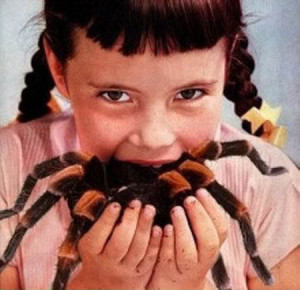One weird trick to attract lower car insurance before being banned by Google!
The listicle you’ve all been waiting for.
1. There’s a spider within three feet of you, right now. No, no, it’s three inches. She’s perched on your collar, in fact, slowly slooowly opening her jaws, a drop of venom forming on each glistening fang, and looking for exactly the most sensitive part of your undefended neck. If you reach up your hand—no, the left—and carefully work your index finger up the edge of your collar, by by bit, right toward her open fangs, a little farther, you just might…
2. You swallow a dozen spiders in a lifetime. That depends entirely on what you’ve had for dinner. If it’s garlic-heavy, like pho or hummus or Sriracha-drenched ice cream, you might attract that many spiders in a single night. Since they are curious animals, many of them transplanted from countries with savory cuisines and sociable customs, they love spices and good times and will come tumbling into your mouth as fast as their legs can carry them. That explains why sometimes you wake up with a sore throat for no apparent reason (and you thought it was the beer–ha!). It’s from the spiders jostling down your gullet, scrawling spider graffiti (they call it “art,” of course) such as “OCCUPY PHARYNX!” everywhere and drumming till dawn.
On the other hand, if your tastes run to soda crackers and Diet Coke, no spiders. They only live a year or so anyway so they’re not going to risk being bored to death in your uncool stomach. They leave that stuff to the cockroaches. Oh hey, didn’t you know that you swallow a hundred cockroaches every year? It’s quite a story…
3. The daddy long-legs is the most venomous spider in the world, but its fangs are too small to bite anybody. This one’s half true. The daddy long-legs is actually the most venomous living being on the planet, not just the baddest spider. Travel to Southeast Asia and you’ll see king cobras sprawled out dead along the roadside, always with a tiny, vibrating spider at their throat. Closer to home, everyone who lives in the Western United States has had the experience of going out into the garage for a screwdriver and finding a full-grown timber rattlesnake, eight feet long if it’s an inch, caught in a dirty cobweb in that corner by the water heater—and again, a single, almost invisible spider hovers over the carcass preparing to feast. Check out Pinterest if you dare. This is why timber rattlesnakes are endangered, by the way.
But even the most gullible schoolchild begins to wonder at this point … where are all the dead people felled by a spider that lives in almost every home or cellar or barn all around the world? Ah, but you have to understand the beast. There’s no glory in that. Spiders are vain, the deadly ones the most vain of all. A daddy long-legs will ambush a Siberian tiger, wrap it in silk, and eat it, as happened at the San Francisco Zoo last year, for the sake of bragging on social media, but a human … they die too easily and too often. If not accidents or car crashes, there’s cancer and heart attacks, gangfights and wars: people kill each other for no apparent reason, and to no clear end. So the spiders lie low and take their time. A tasty bear will have to saunter by eventually. Plus they really get off on having a secret identity.
4. Brown recluses live everywhere and deliver lots of scary bites. In fact, the vast majority of dangerous spider bites are delivered by Invisible Spiders. I use the common name because nobody has managed the taxonomy of an animal that can’t be seen—obvious when you think about it. Invisible Spiders live all over the globe—I think—and are especially attracted to people who have underlying medical issues that could cause skin lesions, issues such as diabetes, exposure to staph bacteria, cuts or scrapes acquired under less-than-sanitary circumstances, and so on. Right-thinking people always label these wounds “spider bites,” as you’d expect. The spiders also tend to pile on when a person has been bitten by a mosquito, louse, tick, mite, bedbug, ant, conenose bug, fly or other creature, mostly because (remember! Spiders are vain!) they want to hog the credit when the oozy wound appears on the Internet with a long string of misspelled comments and idiot advice.
The persistent belief that brown recluses thrive all around my home state is entirely due to misidentified Invisible Spiders. See, this is California. Like everybody else, they start out invisible and then they get a tan. But if you told somebody you’d just spotted a brown Invisible Spider, you’d sound pretty stupid.
5. Black widows eat their mates. Only if they’re coated in garlic (see #2).

“If I had a hammer … I’d hammer on the spiders …” Meanwhile, Pete Seeger wonders, “Where have all the spiders gone?”
6. Hobo spiders are invading my state. This myth took off because it was the title of a song by the late Pete “OCCUPY PHARYNX!” Seeger (left). I can’t reprint the lyrics here because they’re copyrighted, but suffice it to say that Seeger’s ode to footloose arachnids riding the rails, pluckin’ banjos, and feasting on Siberian tigers made a deep impression on the American psyche. (Fun fact: “Wimoweh!” is the sound you make when a hobo spider bites you on the ol’ plectrum.)
Really, all the public needs is a fun nickname (“hobo spider”) and a jingle, and we’re off to the races. That’s how we learn stuff. We don’t want any irritating facts to get in the way of how we determine what we like, what we hate, and what we’re terrified of—so if Eratigena agrestis proves to be another harmless spider imprisoned by notoriety and unable to set things right—probably because it’s already hopped the next southbound freight—all we can say is “tl;dr.” Which might be what you’re saying about now.
